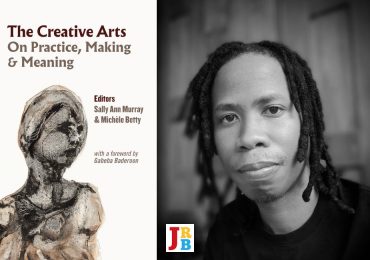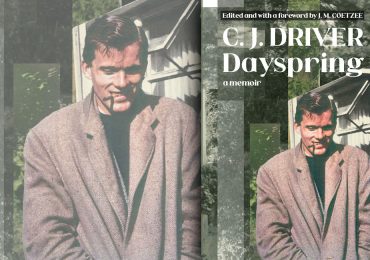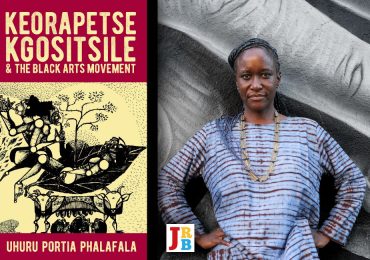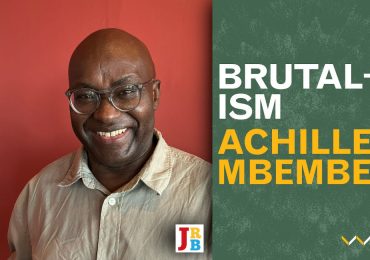After a pleasant day that perhaps included a light lunch in Hotel Zator, they would write postcards to family or friends while enjoying afternoon tea in Hotel Herz. A popular postcard depicted a peacock with sights of the town superimposed upon its spread tail. This relic of local pride is captioned with the cheerful words in Polish and German: ‘Pozdrowieniez Oswiecima’ and ‘Gruss aus Oswiecim’—which mean ‘Greetings from Auschwitz’.
The JRB presents an excerpt from Terry Kurgan’s new book, Everyone is Present: Essays on Photography, Memory and Family, published by Fourthwall Books, and distributed by Jacana Media.
The JRB Patron Ivan Vladislavić wrote of Everyone is Present, ‘Kurgan has achieved something rare in this book: a truly dynamic fusion of text and image. She brings a deep knowledge of craft to everyday images, whether she’s teasing fugitive meanings from a creased pre-war snapshot or taking the pulse of an apparently impersonal digital image. The result is both a moving family memoir and an illuminating reflection on photography and memory.’
Read an excerpt:
A Bomb Also Fell on Mother’s Dining Room
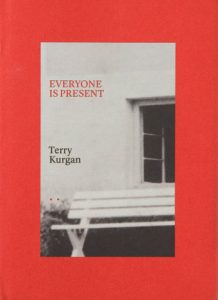 My grandfather locks the door. He pauses at the stairwell windows to look at the garden he has had a hand in, and observes with pleasure the intense blue and purple of the lobelia borders. He notices the patience of the little black dog that is chained to its post, that the plumbago hedge needs pruning, and that his rosebushes are blooming strangely out of season.
My grandfather locks the door. He pauses at the stairwell windows to look at the garden he has had a hand in, and observes with pleasure the intense blue and purple of the lobelia borders. He notices the patience of the little black dog that is chained to its post, that the plumbago hedge needs pruning, and that his rosebushes are blooming strangely out of season.
He bends down to place the keys into a small leather pouch, which he carefully tucks into the bottom of his suitcase underneath his clothes, before he straps it shut. He puts on his hat, straightens his tie and touches the left-hand breast pocket of his coat to check, one more time, that the precious documents folder is in its place alongside an extra set of reading glasses. In the other pocket he can feel his fountain pen and his father’s delicately engraved, gold cigarette case. He takes a few steps towards, and then hesitates for a moment on the landing outside, Mrs. Kara’s front door. He thinks he can hear her moving about in the kitchen. And then he turns back to pick up his suitcase and slowly begins to descend the three flights of stairs to the street below.
It’s threatening rain. The mauve-grey sky is growing thick with clouds. The air feels moist and motionless as he makes his way down Ulica Sixta, along the familiar route to the station. The air-raid alarms have just begun to sound again and he feels remorseful and now also anxious about the early morning’s row, and his stubborn insistence, in spite of his wife’s anger and her tears, upon travelling to the factory.
And yet, it still feels so painful to be leaving. I fear I am abandoning my post too early, but console myself with the thought that I believe in Poland and will be back soon. I hope Mrs. Kara remembers to water my plants. The violets on the balcony are just about to flower.
There’s a great throng of people at the railway station, but the trains are not running to the timetable and are mostly being requisitioned to move the Polish army east. There is no civilian train leaving that night from Bielsko towards Lwów. Instead, he buys a ticket on the next train travelling the short distance to Dziedzice, hoping to be able to connect. Upon arrival he finds the station in total darkness. The Germans are said to be drawing very close and people are in a panic, and trying to find ways to leave the town. Everyone is heading east. A local farmer offers to drive paying passengers part of the way to Kraków in the back of his open truck. And so Jasek heaves himself up and finds a place to sit next to Rabbi Steiner, his wife and his son.
He took us only as far as Auschwitz where we changed to a train.
**
This short sentence plummets through the page, through my desk, through this grey concrete floor, and through the deep-red Johannesburg earth.
But, late at night on the first day of September in 1939, Auschwitz is still simply just a word. The German word for Oświęcim, a small and ordinary market town in the south of Poland, dating back to the twelfth century, with thirteen thousand residents, more than half of whom are Jews.
I want to know the distance between my family’s former home and the Auschwitz station, and so I go to Google Maps, typing in: Bielsko-Biała, the new name of the town since 1951, to Oświęcim, Poland. And up it comes. It is just over thirty kilometres, and at this time of day, by car, under current weather, road and traffic conditions, it should take me approximately thirty-eight minutes.
Head southwest on Lwówska toward Krakowska for 150 metres. Then, take a sharp left to stay on Lwówska for 1.3 kilometres, continuing on to Wyzwolenia. In 750 metres turn right to stay on Wyzwolenia for 1.9 kilometres, and at the roundabout take the second exit onto Janowicka. Drive a further 7.3 kilometres, and then slighty right onto Krakowska for 7.1 kilometres. Continue onto Bielska, a further 2.6 kilometres. At the roundabout, take the second exit onto Turystyczna. Drive for 1.2 kilometres. At the roundabout, take the fi st exit onto Ofi Oświęcimia. Drive for 4.6 kilometres. Continue onto the DW933. Go straight through one roundabout and drive for 3.1 kilometres. Turn left onto Stanisławy Leszczyńskiej and your destination is on your right.
Aside from my astonishment at the fact that they had lived quite this close, Google’s map, shaped of course by social algorithms, reflects the utter impossibility, in 2015, of distinguishing the nine-hundred-year-old Polish-named town from what happened in a German camp on its edges in the middle of the twentieth century. Google doesn’t take me to the centre of the town where my grandfather, now very agitated by the imminent threat of bombs, and the time it might take him to reach the family in Lwów, boards a train expecting to leave for Chrzanow in the early hours of the morning. Rather, it presumes it’s the Memorial and Museum Auschwitz-Birkenau that I want, and takes me to its entrance, with the street address: Więźniów Oświęcimia 20, 32-603 in Oświęcim, Poland.
In 1939, the Jews have their own name for the town: Oshpitzin, which comes from the Aramaic word for guest. It lies sixty-seven kilometres south of Krakow, three hundred and twelve kilometres southwest of Warsaw, and is close to the confluence of the Soła and Vistula Rivers. Ordinary people live there, and until just a few days before Jasek’s brief stopover, tourists would visit to see the medieval hilltop castle, the churches, the large and ancient market square and the Great Synagogue. After a pleasant day that perhaps included a light lunch in Hotel Zator, they would write postcards to family or friends while enjoying afternoon tea in Hotel Herz. A popular postcard depicted a peacock with sights of the town superimposed upon its spread tail. This relic of local pride is captioned with the cheerful words in Polish and German: ‘Pozdrowieniez Oswiecima’ and ‘Gruss aus Oswiecim’—which mean ‘Greetings from Auschwitz’.
In just over six months’ time, in the spring of 1940, Captain Rudolf Höss of the SS will journey through Poland to become Commandant of a new concentration camp. He will travel to the outskirts of this town in the middle of territory seized by Hitler. Here he will take up residence in the castle and begin to imagine the camp: the very first Auschwitz, later known as the ‘Stammlager’ or ‘Auschwitz 1’. It began life as a collection of dilapidated former Polish army barracks set around a huge horse-breaking yard and was built not to hold Polish Jews—who were initially to be confined in ghettos—but chiefly Polish political prisoners, and anyone else the Nazis considered a threat to their occupation. The growth and development of the camp until it stretched for forty square kilometres, the extension of the railway tracks so that they ran directly from
the town through the gates of the camp selection ramp to the gas chambers; the deaths, the crematoriums. These all came later.
**
There was in the end no hope to get any further. All the trains were fi ed with our soldiers, setting out to this war as if they were going to a wedding! We were forced to get out and try and find a bus to take us further on our journey. In the end it was partly by foot and partly by horse and cart that we made our way to Kraków, where we discovered that it was out of the question to travel any further without a permit from the county offi e. I now felt so tired, and so troubled, that I was really quite content to be forced to spend the night, and I set off to find a hotel room with a restaurant and a bath. After a dinner of cabbage soup and a goulash over seasoned with salt, I slept dreamlessly and like a stone, waking quite abruptly at exactly 6 am.
It’s 3 September, and after breakfast, at more or less the same time as he reclines upon a comfortable leather seat at the barber shop waiting for his haircut and shave, the German army, some one hundred and twenty kilometres away in the direction from which he has just come, enters his home town. Many people still attempting to flee the city are forced to return as their escape routes are cut off.
**
I had to know what might have happened had my grandfather still been at home on that day, and so I hunted online and came across All But My Life, the memoir of Gerda Weissmann Klein. She was fifteen years old, and living with her parents and older brother in more or less the same neighbourhood as Jasek, Tusia and their daughters, when the invading army marched into and occupied Bielsko.
Had he still been at home watching the street from his third- floor window, Jasek would have heard the rumbling of tanks and sporadic shooting from the rooftops, and then he would have seen large platoons of German soldiers being discharged into the streets off grey trucks, and motorcycles with sidecars. Later in the day he might have gazed down upon a carousing and jubilant mob, a large number of whom were his friends, acquaintances and neighbours, smiling broadly as they extended their right arms in the Hitler salute, waved swastika flags and served the soldiers— many of whom were on horseback—cake and wine. They were a part of the population who had never stopped yearning for Bielitz in Austrian Silesia, the old name of the predominantly German- speaking Austro-Hungarian provincial capital after which, in spite of the strict policy of Polonisation since the end of the First World War, many of the bourgeoisie still hankered. He might have noticed his neighbour Mrs. Kara, handing an SS officer a bunch of the late-blooming roses that he had been so proud of.
**
I borrowed this last incident from Gerda Weissmann Klein’s description of that day, which merged so serendipitously with my grandfather’s observation upon leaving his home that the roses had bloomed out of season that year. She remembers how it had angered her to notice that a neighbour had picked her mother’s beautiful white roses and given them to a German officer, only to see the man drop them to the ground a moment later when he was handed a glass of schnapps.
Some months after writing this passage, in another of my online forays, searching for evidence of pre-war public life in Bielsko, and what might have happened on that day, I came upon a short video on YouTube with the title: Bielsko-Biala 1939–2014.15 It was one of those ubiquitous, homemade short films uploaded to this popular platform, made with still photographs and—usually, but not in this case—set to a music soundtrack.
It begins in silence, with a 1939 black-and-white photograph of a platoon of German soldiers on horseback entering the city of Bielsko. They are smiling and saluting. The image seems to be resting upon a flat surface, and the person who made this video zooms in, and with a slow, unsteady pan across the image, focuses our attention on the detail that will enable us to notice that he is juxtaposing this photograph and the city as it appeared in 1939, with his next shot, which is full-colour video footage—with sound—of exactly the same spot in 2014. We see the same curve in the road—now paved with asphalt—contemporary shop-fronts, cars and pedestrians, and we hear the fast-moving traffic as it rounds the bend.
He does this twice in relation to the first photograph, and the second time, as he pulls away from the photograph, I notice it is in an album propped up against a computer monitor. He shows us two more old stills shot in two slightly different positions, of German soldiers astride a horse-drawn cart behind a group of other soldiers on horseback, and then once again homes in on their present-day locations.
**
And then, he shows us this one.
That senior officer in the lead, in full SS regalia, his right arm bent into a salute in acknowledgement of the enthusiastic welcome he and his men are receiving from the crowd lining the streets, is holding a bunch of white roses.
This is such a precise and visceral encounter with the past. What are the chances of an observation my grandfather makes and records in his dairy in 1939, aligning with an incident described in a memoir first published in 1957, and all of that actually existing in a photograph taken on the very day described, but stored in a family album, until it makes its way into an amateur home-movie uploaded onto YouTube in 2014.
Almost everyone in this photograph is smiling. At certain moments the photograph’s full caption is visible: ‘Einzug der deutschen Truppen in Bielitz, 3/9/1939’, and so it is clear, when we know that the town’s name was changed to Bielsko twenty years prior, where the sympathies of this amateur historian lay. When I type ‘Einzug der Deutschen Truppen in Bielitz’ into Google Translate, ‘Entry of German troops in Bielsko’ is what it turns up. And the officer is still holding his bunch of white garden roses. He hasn’t yet dropped them to the ground, so there is something redemptive too, about that.
On 3 September 1939, just a few blocks away from the location of this image, other groups of soldiers were burning down the Great Synagogue—architect Karol Korn’s grandest building—and forcing the rabbis to throw their sacred books and Torah scrolls into the fire. My grandfather would have noticed the flames once they had reached the tall Moorish spires, which towered over the apartment buildings across the road from his own. The next day the Germans will begin to strip Jews of their property and assets. Large Jewish- owned factories, warehouses and shops will be confiscated immediately. The Germans will also issue a series of rulings demanding that Jews hand over their jewellery, silver and any other valuables, and in addition to this: their radios, their bicycles and fur coats.
**
About the book
On the basis of a detailed war-time diary and a collection of family photos left by her grandfather, Terry Kurgan builds a gripping family memoir/detective story that takes us from Poland through Romania, Turkey and India to South Africa. Balancing her account of this global Jewish refugee journey with illuminating microscopic readings of seemingly ordinary images, Kurgan invites us into the intimacies of family in conditions of extremity, even as she zooms out again to explore the revelatory power and the frustrating limits of photographs in our search for the textures of past lives.
—Marianne Hirsch, author of The Generation of Postmemory: Writing and Visual Culture after the Holocaust
In this book, Terry Kurgan begins with a family snapshot made by her Polish grandfather in 1939 on the eve of the war. Presenting this evocative image as a repository of multiple histories—public, private, domestic, familial and generational—she sets off on a series of meditations on photography that give us startling insights into how photographs work: what they conceal, how they mislead, what provocations they contain. Each essay takes up the thread of the story of her family’s epic journey across Europe as they flee—country by country—Nazi occupation, until they reach Cape Town, South Africa. But Kurgan takes detours, circles back, diverts attention elsewhere, enriching and also disrupting the narrative with digressions on the way Google has changed our relationship to photography, on her grandfather’s eloquent daily journals, on the shipboard flirtations of her fascinating grandmother, on vanity, on self representation, on loss and return, home and exile. Kurgan’s richly satisfying essays are part memoir, part travelogue, part analysis and they demonstrate her sophisticated understanding of a medium that has long engaged her as an artist.
- Terry Kurgan is currently Artist in Residence at the Wits Institute for Social and Economic Research (WiSER).



